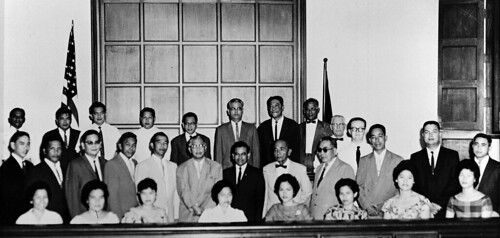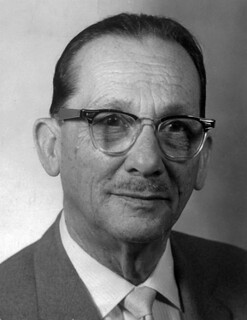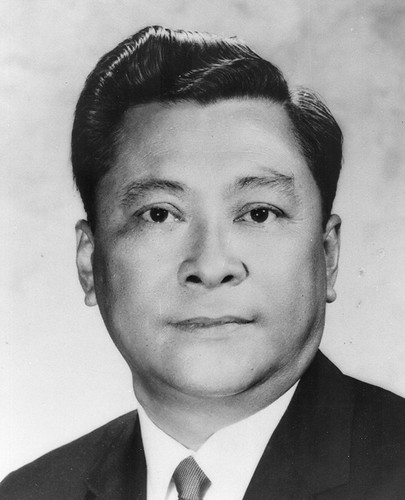View more photos for the Elective Governor Act 1968 entry here.
The Guam Elective Governor Act was passed by the United States Congress on 11 September 1968 and granted the people of Guam the authority to elect the Governor and Lieutenant Governor of Guam. Known officially as Public Law 90-497, the Elective Governor Act declared that the majority of qualified Guam voters would jointly choose the Governor and Lieutenant Governor and set the first election date for 3 November 1970. According to the Act, subsequent elections for these offices would be held every four years, and limited the elected governor to two full successive terms; only after another full term passed could a former governor be re-elected to hold that office again.
Under a civilian executive branch
The Organic Act of Guam established a civilian executive branch of government for the island in 1950. However for the first twenty years after it was passed the President of the United States, not Guam voters, selected the governor. During this time of appointed governors the executive branch was considerably stronger than the legislative branch. This was a carry-over from the many years of naval rule, when the naval governor had near authoritarian power. If a two-thirds majority in the Guam Legislature overrode a governor’s veto, the governor could pass the legislation on to the Secretary of the Interior (the President’s Cabinet post that had jurisdiction over Guam) and ultimately to the President, who could override the legislature. According to former appointed Secretary of Guam (equivalent of lieutenant governor), Kurt Moylan, the appointed governor would follow directives from the Secretary of the Interior. Moylan also noted the very close relationship between the governor’s office and the commander, Naval Forces Marianas (ComNavMar), with whom they communicated on a regular basis. Moylan highlighted the fact that Guam’s governor was closely tied to the federal civilian and military authorities while having no direct political relationship to Guam voters.
From the establishment of the Government of Guam in 1950, members of the Guam Legislature resented this inequality among the branches of local government, but it was not until the 1960s with the advent of the first appointed Chamorro governors, that a push for elected governorship gained momentum. Guam’s first Chamorro governors, Joseph Flores (1960-61) and Manuel FL Guerrero (1962-1969) both advocated a move to elective governorship.
Aside from the consensus that Chamorros wanted and asked for the right to elect the island’s governor, historians present differing views as to why the federal government chose to grant this right. According to Pedro Sanchez, “the success of Flores and Guerrero encouraged the Congress of the United States to amend the Organic Act of Guam to allow for the election of the island’s governor and lieutenant governor.” On the other hand, Guam political leader Carlos P. Taitano and historians Robert F. Rogers and Penelope Bordallo Hofschneider suggest that, far from being simply a reward for these governors’ competent leadership, the right to elect Guam’s governor was won through a sustained struggle on the part of Guam legislators that involved both local and national politics.
On 30 January 1962, the 6th Guam Legislature sent the first of many petitions lobbying the US Congress for elective governorship. The Legislature argued that Chamorros had demonstrated a level of loyalty, political development, and assimilation to American ideals commensurate with the responsibilities of the self-government of a US territory. However, this and several similar petitions died in congressional committees. A final, ultimately successful, push began in 1965. During this year, former Guam Legislative Speaker Antonio B. Won Pat moved to Washington, DC and began to work as Guam’s unofficial lobby on issues relating to Guam. Won Pat had been elected to this position through a special election on Guam to represent the island in the nation’s capital, but without funding nor congressional standing. In Guam, the newly elected majority Territorial Party, selected longtime Guam statesman Carlos P. Taitano as the Speaker of the Guam Legislature.
Taitano immediately began to criticize appointed governor Manuel FL Guerrero for his involvement in local Democratic party politics. It should be pointed out that the appointed governorship was a very politicized position since US presidents appointed governors that aligned with their own national party affiliation. For example, John F. Kennedy appointed Guerrero in part because he was a fellow Democrat. When Richard Nixon was elected US President, Guerrero resigned and Nixon appointed Republican Carlos G. Camacho. With shared local and national party affiliations, it made sense that Guerrero would support the Democratic minority in the Guam Legislature. But, because appointed governors answered to the president and not to Guam voters, Taitano argued that Guerrero’s actions constituted “an unfair extension of the power of the White House in local politics to the advantage of the opposition party.”
Taitano, having successfully led the movement for citizenship 15 years earlier, knew how to harness the power of the national media to influence Washington politics. In 1965, he led a three-man delegation across the country, stopping in Hawaii, San Francisco, and even Independence, Missouri, where he met with former president Harry Truman, who had signed the Organic Act in 1950. Everywhere Taitano went, he alerted people to the incomplete democracy that still existed on Guam. He made sure that his actions were publicized in major news outlets including the New York Times and Washington Post which were read by most members of the US Congress. While the impetus for the trip had been his complaints about Governor Guerrero, he lobbied to fix structural imbalances in the territorial-federal relationship on three fronts: elected governorship; a representative to Congress; and the right to vote for President of the United States.
In Washington, DC Taitano was discouraged to learn that President Johnson would not speak to him in person regarding these issues. At the White House, Interior Department officials “castigated” the Guam delegation, but he found that State Department officials were more receptive to their pleas. It is likely that, just as in the earlier push for US citizenship, the core source of conflict within the federal government was the tension between America’s public face as a champion of freedom and democracy and its strategic needs as a colonial power.
The US military resisted any changes that shifted power from the federal to the local government, but, by 1966, the combined work of Taitano, Won Pat and numerous others who had helped in this effort had raised public awareness in Washington of the lack of true democracy on Guam. According to Taitano, “it was clear that Congress would have to grant more home rule to Guam.” Congress passed the Elective Governor Act in 1968, setting up the first gubernatorial elections in Guam history in the fall of 1970.
Impact of the Elective Governor Act
The passage of the Elective Government Act fundamentally changed the Government of Guam’s (GovGuam) relationship to the United States. The head of the local government now had to answer to the people of Guam. This was not a power that the federal government gave up lightly. The Act suggests a considerable level of distrust of local rule by giving the Interior Department unprecedented power to audit all GovGuam accounts and tax records at any time.
In another example of give and take, the Act took away the preferential hire status for Chamorros in federal jobs on Guam. This action seems to point to a pattern that was also evident in the political status negotiations of the 1980s and 1990s. The federal government appeared it would only grant Chamorros greater rights as US citizens if Chamorros relinquished rights deriving from their special status as the indigenous people of the island.
Despite these compromises, the Elective Governor Act instituted a more complete form of democracy on Guam. The impact of elective governorship on local politics was immediately evident as former appointed Governor and Secretary, Carlos Camacho and Kurt Moylan made their transition to their new roles as elected Governor and Lt. Governor in January of 1971.
The Guam Legislature was eager to test out its new powers and soon became embroiled in a battle over the right of the military to acquire land for an ammunition wharf at Sella Bay. The agreements between the Camacho administration and the Navy had been settled largely under the appointed governorship, but now the rules had suddenly changed. The Democrat-led Legislature’s successful opposition to the Sella wharf rested on Guam Senator Paul Bordallo’s ability to pass a law in the Guam Legislature that made it illegal for the governor to alienate Government of Guam owned property without approval of the Legislature. Such a law could never have been passed during the period of appointed governorship because the president would have taken the side of the governor and the Navy and vetoed the bill.
In a 2002 interview, Moylan gave a sense of the enormity of the adjustment that he and Camacho went through during these years. He characterized the appointed governor era as “basically a totalitarian type of administration. Washington ran everything. The Navy called the shots for Washington.” Under his new role as elected Lt. Governor he recalled, “when you transition from appointed to elected, you forget that you no longer respond to the Secretary of the Interior. You’re supposed to be working with the Legislature.”
Even with elected governors, the executive branch in Guam retains powers that stem from the authoritarian roots of the position, and the struggle to limit the powers of Guam governors continues to be a point of contention between governors and legislators to this day. Nevertheless, the passage of the Elective Governor Act in 1968 was a victory for the people of Guam, who now participate more fully in a democratic local government.
The story of the Elective Governor Act highlights the reality that even after the granting of United States citizenship through the Organic Act of Guam in 1950, the United States Federal Government was resistant to giving Chamorros full control of the local government. Truly, no rights have been simply “given” to Chamorros under American rule. Each major adjustment in the federal-territorial relationship has been the result of persistent struggle.
For further reading
Ada, Joseph, and Leland Bettis. “The Quest for Commonwealth, the Quest for Change.” Kinalamten Pulitikåt: Siñenten I Chamorro (Issues in Guam’s Political Development: The Chamorro Perspective). The Hale’-ta Series. Hagåtña: Political Status Education Coordinating Commission, 1996.
Hofschneider, Penelope Bordallo. A Campaign for Political Rights on the Island of Guam, 1899-1950. Saipan: Commonwealth of the Northern Mariana Islands Division of Historic Preservation, 2001.
Moylan, Kurt. “The Sella Bay Ammunition Wharf Controversy 1969-1975: Economic Development, Indigenous Rights, and Colonialism in Guam.” Interview by Michael Clement, Jr. Unpublished MA thesis, University of Guam, 2002.
Rogers, Robert. “Gibraltar of the American Lake 1945-1950.” In Destiny’s Landfall: A History of Guam. Honolulu: University of Hawai’i Press, 2011.
Sanchez, Pedro C. Guahan Guam: The History of Our Island. Hagåtña: Sanchez Publishing House, 1987.
Taitano, Carlos. “Guam: The Struggle for Civil and Political Rights” in Micronesian Politics. Suva: Institute of Pacific Studies of the University of the South, 1988.





